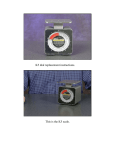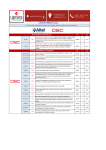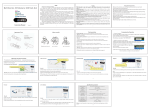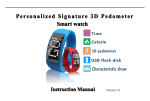Transcript
EV-DW4975 Vanishing Door/Window Contact Installation Manual Introduction The EV-DW4975 is the industries thinnest supervised door/window contact allowing a multitude of applications while hiding the transmitter on a door or window frame. The EV-DW4975 uses a replaceable lithium battery and should last 5 years under normal usage. • Frequency 433.92 • Transmission: ASK • Operating Temperature: -10C-+50C • Nominal Battery Life: 5 Years. Varies with Usage and Temperature • Battery Type: Panasonic CR2032 Figure 1 Figure 2 FCC COMPLIANCE STATEMENT This device complies with Part 15 of the FCC Rules. Operation is subject to the following two conditions: (1) This device may not cause harmful interference, and (2) this device must accept any interference received, including interference that may cause undesired operation. IC: The term ‘IC:’ before the radio certification number only signifies that Industry Canada technical specifications were met. Technical Support: (866) 908-TECH (8324) Figure 3 Figure 4 EV-DW4975 Vanishing Door/Window Contact Installation Manual Introduction The EV-DW4975 is the industries thinnest supervised door/window contact allowing a multitude of applications while hiding the transmitter on a door or window frame. The EV-DW4975 uses a replaceable lithium battery and should last 5 years under normal usage. ©2006 Secure Wireless Mount Transmitter and Magnet 1) Mount the EV-DW4975 on any window or door frame using the supplied double strick tape or screws (Figure 5). 2) Find the notch on the outside of the EV-DW4975 enclosure. Align the magnet with the notches and ensure that the distance is no greater than 5/8 of an inch (Figure 6). Figure 5 Enrolling Refer to your installation manual for enrolling wireless devices into a DSC control panel. Figure 6 Specifications Install or Replacing the Battery • Frequency 433.92 • Transmission: ASK • Operating Temperature: -10C-+50C • Nominal Battery Life: 5 Years. Varies with Usage and Temperature • Battery Type: Panasonic CR2032 The EV-DW4975 uses a Panasonic CR2032 Lithium Battery and is shipped not installed to save battery life. Figure 1 Figure 2 Use care when installing the battery and observe the correct polarity when the battery is inserted. Use only Panasonic Lithium CR2032 batteries for replacement. WARNING!: Battery may explode if mistreated. Do not recharge, disassemble or dispose of in fire. Figure 6 Specifications Use care when installing the battery and observe the correct polarity when the battery is inserted. Use only Panasonic Lithium CR2032 batteries for replacement. Follow the steps below to install or replace the battery. 1) Using a coin (Figure 1) or a flat head screw driver (Figure 2) insert into the notch located on the case and gently twist to open. Lift up and pull the case outward to open (Figure 3). 2) Insert Battery (figure 4) + side facing UP. Figure 5 Refer to your installation manual for enrolling wireless devices into a DSC control panel. The EV-DW4975 uses a Panasonic CR2032 Lithium Battery and is shipped not installed to save battery life. WARNING!: Battery may explode if mistreated. Do not recharge, disassemble or dispose of in fire. 1) Mount the EV-DW4975 on any window or door frame using the supplied double strick tape or screws (Figure 5). 2) Find the notch on the outside of the EV-DW4975 enclosure. Align the magnet with the notches and ensure that the distance is no greater than 5/8 of an inch (Figure 6). Enrolling Install or Replacing the Battery Follow the steps below to install or replace the battery. 1) Using a coin (Figure 1) or a flat head screw driver (Figure 2) insert into the notch located on the case and gently twist to open. Lift up and pull the case outward to open (Figure 3). 2) Insert Battery (figure 4) + side facing UP. Mount Transmitter and Magnet FCC COMPLIANCE STATEMENT This device complies with Part 15 of the FCC Rules. Operation is subject to the following two conditions: (1) This device may not cause harmful interference, and (2) this device must accept any interference received, including interference that may cause undesired operation. IC: The term ‘IC:’ before the radio certification number only signifies that Industry Canada technical specifications were met. Technical Support: (866) 908-TECH (8324) Figure 3 Figure 4 ©2006 Secure Wireless








